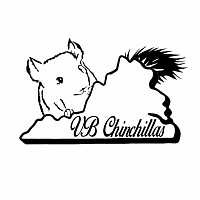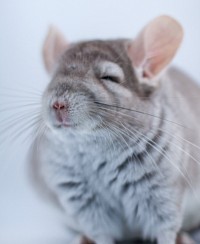Housing, Feeding and ETC.
Your chinchilla's cage should be a wired cage, free of all plastic. If your cage comes with plastic you can cover it with non pill or blizzard fleece. Never use a glass aquarium for a chinchilla cage, they will overheat easily and that will cause death. I recommend the Ferret Nation 182 cages. These cages come with plastic pans, that you can either cover with fleece or replace with bass equipment metal pans. The fleece can be washed 2 times a week with vinegar and laundry detergent. Do an extra rinse to make sure the perfume from the detergent is fully rinsed out. Then either air dry or tumble dry low. I suggest purchasing 2 sets of fleece liners so one can be used while the other washes and also if one get torn you have something else to use until you can replace it. All of my chinchillas love fleece covered pvc tubes which I wash 1 time a week. They also love hammocks that are very thick and this makes them more sturdy. I can recommend Fleece for Furries (on facebook) for all your fleece needs. Chinnie boutique (on facebook) for custom hammocks and cubes, and Chinchillacity.com for tubes, hammocks and corner hammocks. I have purchased from all of the vendors myself and their products are top quality. You can purchase kiln dried pine ledges for your chinchillas to hop on, or make them yourself. If you want to make them yourself you will need kiln dried pine wood, cut into lengths you want. Hanger bolts, washers and wing nuts.
Items you will need for your chinchilla cage
*I RECOMMEND KILN DRIED PINE BEDDING SUCH AS PINE RIVER (FINE SHAVINGS) OR THE BEAVER BAG (BIGGER FLAKES)
Ceramic or stainless steel bowl
Hay holder (do not purchase the wired or plastic hay racks, and do not use a hay ball or one that spins around)
Water bottle (chew proof glass is best, I use kaytee chewproof 12 oz water bottles)
Wooden or metal ledges for jumping on (different lengths) Tiffany's chinchillas sells metal and wooden ledges.
Blue cloud, chill dust or blue sparkle dust
PVC fleece covered tubes for sleeping
Shavings/bedding (aspen or kiln dried pine) unless you are using fleece
Dust bath container. (can be plastic as long as not left in cage unsupervised)
Hiding house/large tropical fiddle sticks to hide under, sit on and chew on
Hanging toys (most sold in pet stores are not safe, check out chinchillacity.com for great toys)
Sticks (Rondaschins.com sells great sticks for your chinchillas. properly prepared and ready to chew I recommend apple and pear)
Wheel (not necessary but if you want one, make sure it is 15 inches or larger around, I recommend the chinspin.
Feeds and treats
Chinchillas shall not have any fruits, nuts, veggies or seeds as it can cause bloating and high sugar levels in your chinchilla. Most pet store feeds and treats are unsafe and have those little treats crammed in the bag. DO NOT FEED TREATS TO A CHINCHILLA UNDER 6 MONTHS OF AGE. Remember that 80% of a chinchillas diet is hay so always keep a hay supply in there cage. If any questions ASK A BREEDER.
Feeding new feed
Feed the feed from the previous ranch for about a week and then mix 1/2 and 1/2 with your feed to make a gradual change.
Unsafe feeds and treats
•kaytee
•sunburst
•oxbow garden select
•vitakraft
•yogurt bites
•yogurt pretzels
• fruits and veggies
•yogurt/seed sticks
•sunflower seeds
•peanuts
•oxbow reward biscuits
Anything do do with nuts, fruit, seeds and veggies. Basically all pet store treats are bad.
Safe feeds and treats
Rabbit feeds chins can have
•Mana pro (or sho)
•blue seal show hutch deluxe
•Purina show rabbit feed
•Kalmbach 16% rabbit feed
Chinchilla feeds
•Hubbard life (tradition)
•Mazuri
•oxbow (red bag)
•Kalmbach (Tribute) chinchilla feed
**Treats shall be given in moderation.**
Safe treats
•rose hips
•rolled oats
•slow cooked old fashion oats
•plain cheerios
•shredded wheats (unfrosted)
•bees pollen
• dried hibiscus
You can get safe treats from TJ's chinchilla supplies listed in my Education/vendor section.
Hay
•Timothy
•orchard
•hay cubes (mainly Timothy/alfalfa mix)
•alfalfa (give in moderation as it is very high in calcium.)
•oxbow hay
*DO NOT GET THE HAY WITH THE VEGGIES AND FRUIT IN IT.*
Safe and unsafe wood chews
SAFE WOOD:
Apple
Arbutus
Ash
Aspen
Birch - White(Silver or Common Birch )
Bamboo
Broadleaf
Blackberry
Black Currant
Cholla ( some form of cacti)
Cottonwood
Crabapple
Dogwood
Elm
Balsa
Grey
Grapevine
Hawthorn
Hazelnut
Kiwi
Larch
Magnolia
Manzanita
Mulberry
Ocotillo
Pine (Kiln Dried Only)
Pear
Pecan
Poplar
quince
rose
sycamore
Sequoia (Redwood)
Willow (Not white willow)
Yucca
UNSAFE WOOD:
Almond
Apricot
Beech
Black Locust
Black Lotus
Blackwood
Buckthorn
Cashew
Cedar
Cherry
Chestnut
China berry
Chinese Snake tree
Chokeberry
Citrus woods such as oranges, lemons, limes and etc
Eucalyptus
Holly
Honey
Locust
Hydrangea
Juniper
Mango
Plywood
Maple
Mesquite
Myrtle
Un kiln dried pine
Cherry
Peach
Prune
Plum
Nectarine
White Willow


